* Editor Note: Analysis was done prior to COVID-19 Pandemic
” There is no doubt in our mind that copper is a fundamentally strong commodity on a long-term perspective, helped by increased demand penetration in areas such as renewable energy and electric vehicles, and a supply side which has a great tendency to disappoint.”
There is no doubt in our mind that copper is a fundamentally strong commodity on a longterm perspective, helped by increased demand penetration in areas such as renewable energy and electric vehicles, and a supply side which has a great tendency to disappoint. However, just as with any other commodity it will have cycles of imbalance between supply and demand, and we expect a number of these over the coming years. As global industrial production recovers, helping ex-China demand, we see the current year as having the largest deficit seen over the past decade. However, miners do like building copper projects, and there are a number in the pipeline, which will have to be absorbed over 2021-2023. In turn, a combination of visibility on delivery of such projects and prices below long-term incentive expectations have served to stall further capital investment, setting up a supply gap by the middle of the decade. From an investment point of view, the key is timing these changes in market dynamics.
2019 in Review – A Lack of Supply and Demand Growth
Just like many commodities, global copper demand growth disappointed last year. With industrial production dropping to a decade low, and purchasing managers nervous, many key end uses saw stagnant or falling demand. Indeed, with industrial output ex-China in decline, we estimate ex- China copper demand dropped 1.2% on the year. Notably, European demand dropped 4.8%, with Japan down 2.5%. For much of the year it also looked as though Chinese demand would be negative for the first time since 2006, indeed real demand through September dropped 0.8% y/y. However, a strong year end recovery saw the year as a whole +1.5%.
However, the trend of China reducing its overall call on refined metals markets continued, with a fall in net cathode imports despite a sharp rise in December. Meanwhile, China’s net semis imports fell to the lowest level in history, while the path towards self-sufficiency at yet another part of the value chain continued with China seeing aggregate copper product exports exceed imports for the first time. Even taking account of this, Chinese demand was still positive, albeit only +0.9%.
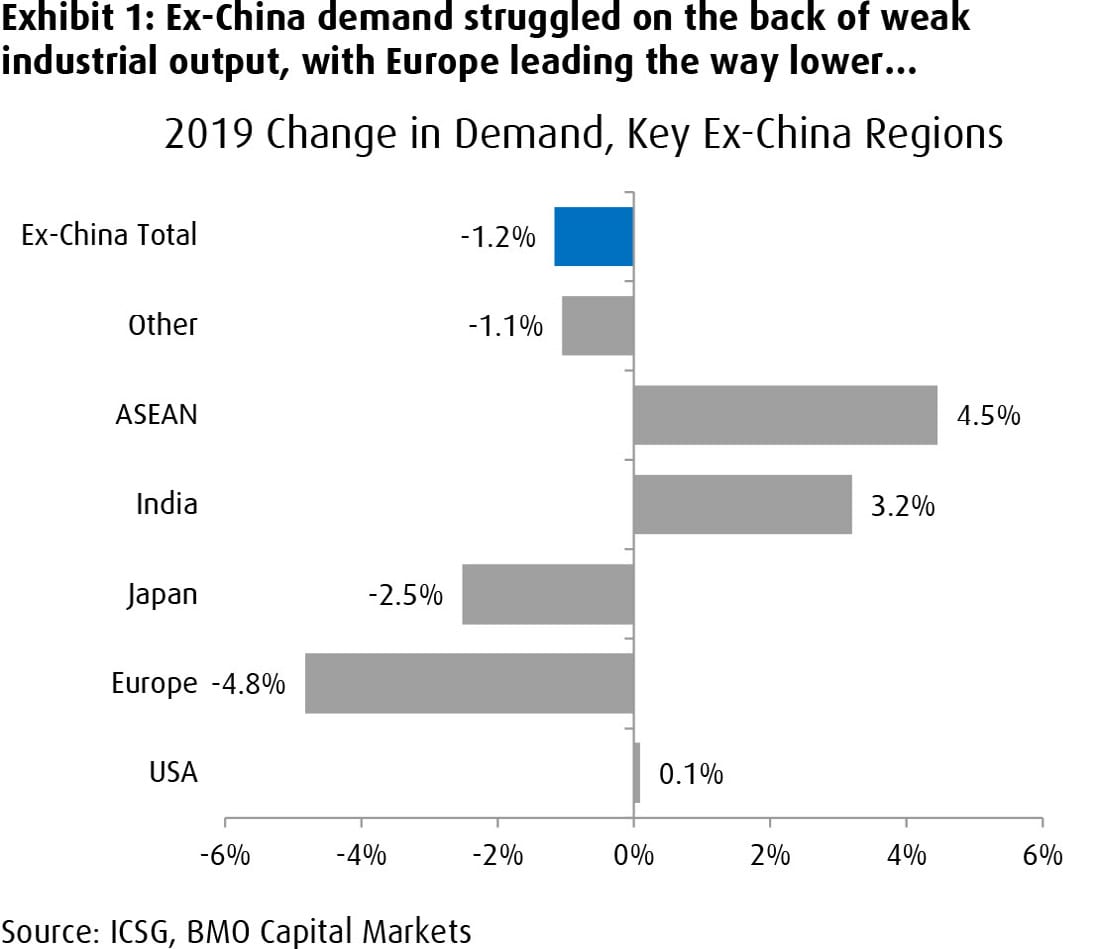
With this lack of demand aggression, the annual average copper price fell 8% y/y as strength in Q2 faded. Only 2015-2016 saw a lower average since the Global Financial Crisis. However, on a longer-term basis this was almost exactly in line with the long-term real average, which in a weak demand growth environment, without competition for units can be considered a reasonable price.
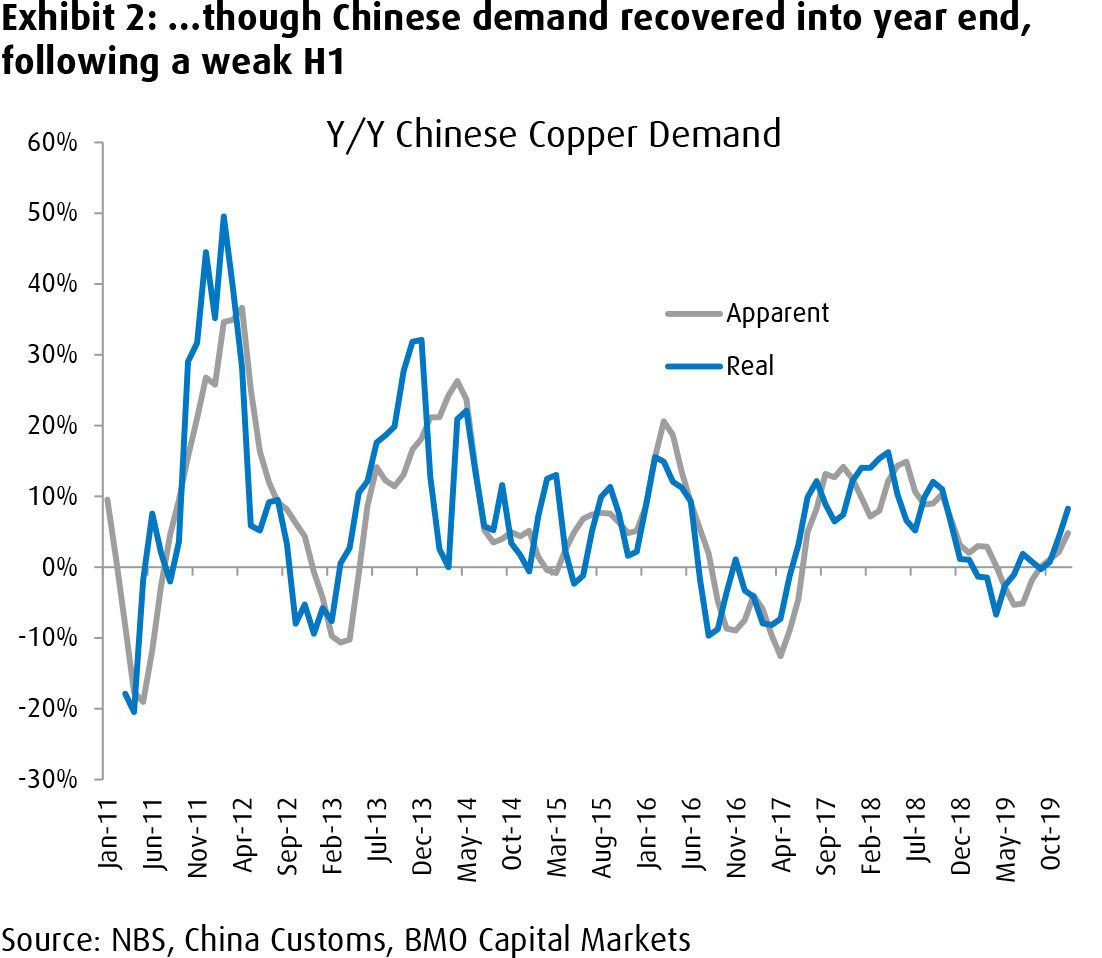
Indeed, with global demand growth of just 170kt in the year, the price situation could well have been worse had it no been for mine supply holding up its end of the bargain. While the coming weeks will bring final production figures from most of the larger producers (both at a country and company level), we anticipate global mine supply will have fallen by 0.2% this year. Indeed, global mine supply may be <100kt higher than in 2016, which naturally has led to a tightening in the copper raw material market and a fall in both spot and contract treatment and refining charges, which have fallen to multi-year lows.
Of course, for cathode we mentioned that without demand growth, prices struggle to perform. And the same is true for concentrate. However, unlike cathode, China’s pull on the concentrate market continues to grow in order to serve the domestic smelting industry. 2019’s 22.5mt gross weight imports compare to just 7.8mt in 2012, and are over 2mt above 2018 levels despite the lack of supply growth. Trade data showed that, Chile’s smelting problems did free up more concentrate for export, but in our view more important was the output weakness at ex-China smelters.
The net impact of supply and demand dynamics was to see global inventory fall by ~160kt over the year. Exchange stocks were marginally down over the year, but the big drop was in Chinese bonded stocks, which dropped 155kt in their own right. Indeed, we have been asked why our deficit is not higher given this, but we would highlight that the unrest afflicting Chilean ports in Q4 does look to have resulted in an inventory build up at this part of the value chain.
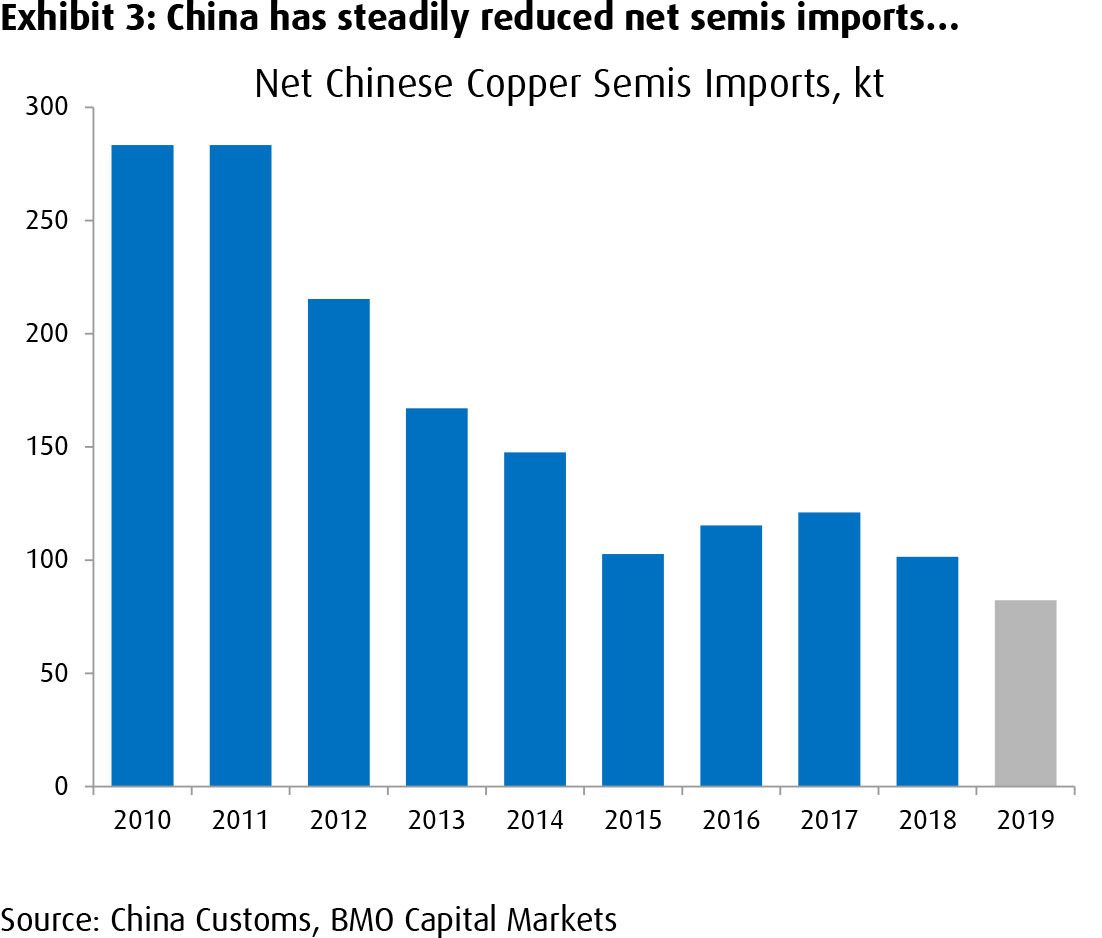
2020 – A Deficit, With Ex-China’s Scale of Recovery Determining Price Amplitude
2019 ended with strong price momentum (indeed the 31st December price was up on end 2018 levels), and this has continued into 2020. Certainly, the Phase 1 US-China trade agreement has gone a long way in helping risk-on sentiment across global markets, and even heightened Middle East tensions caused only a temporary derailment. We do believe that the destocking cycle across global manufacturing has
ended, which will involve purchasing managers seeking to source additional metal units. However, seasonally January is the weakest part of the year for underlying industrial demand, accentuated by the Chinese New Year holiday. Physical copper premiums are testament to this, currently trading back at the levels seen this time last year. Thus, it is fair to say financial markets have aided the price rally, with the net short position which had built up during escalating trade friction now closed out. In our view, copper is trading slightly ahead of underlying fundamentals at the present time, and physical data points post Chinese New Year will determine whether the fundamentals will catch-up to the rally.
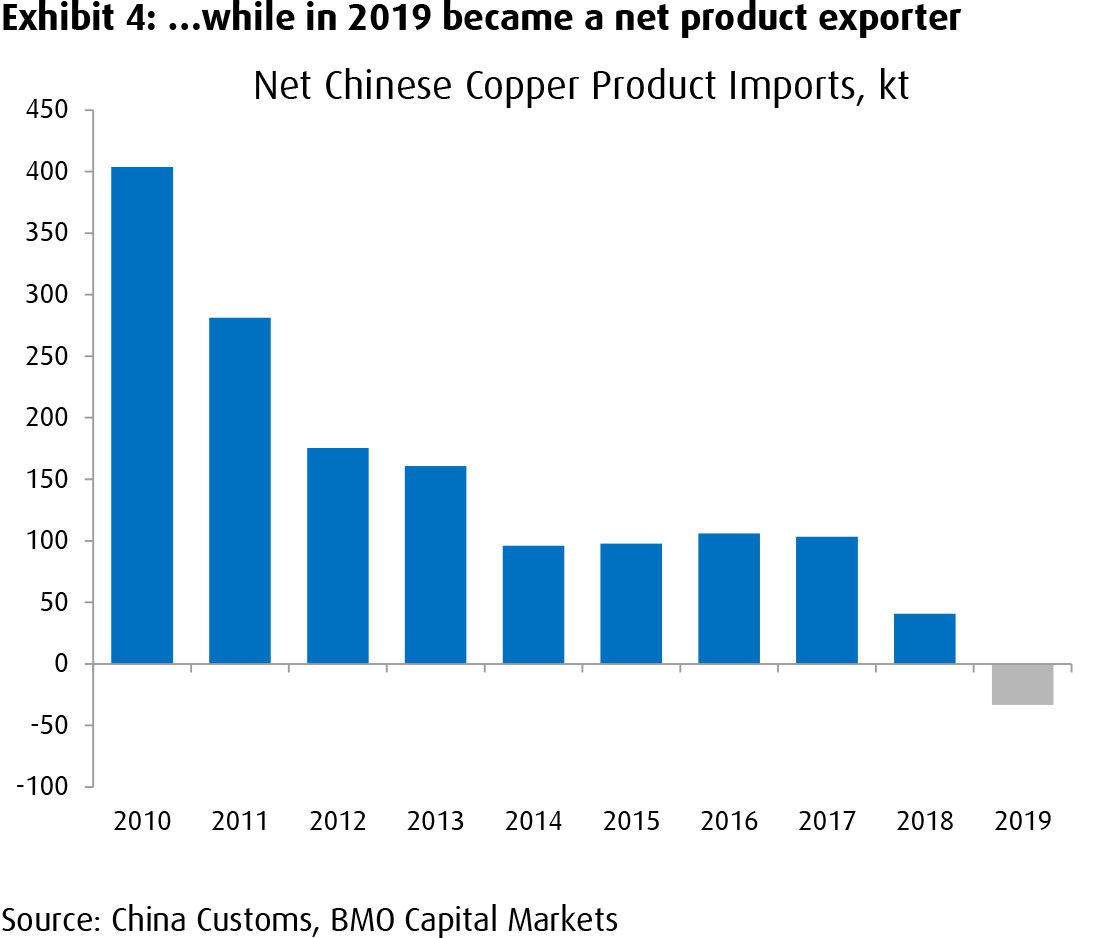
We are cautiously optimistic that they will. The recent gains in Chinese demand point to expectations of a better demand environment, with the steadily loosening monetary policy and pick-up in credit velocity likely helping. We see 2020 as a big year for the Chinese economy, being the line in the sand where President Xi has promised to double per capita income over 2010 levels and when the 14th five- year plan is announced. As with every year, growth has to be supported, and at least one of the old school pillars of fixed asset investment will be leaned on hard to provide it. Yet again, the burden looks to be falling on the property market – particularly as impacts in this area tend to reverberate through the entire industrial economy. Indeed, Chinese data shows a strong trend for construction orders to drive manufacturing expectations. Thus, we expect Beijing to turn a blind eye to local governments easing the shackles on property developers, provided part of the plan is to address the shortage of <90spm apartments for low-medium income households. In particular, positive construction completions – a situation not seen over the past couple of years – should be positive for copper demand through increased wiring and
appliance flow-through.
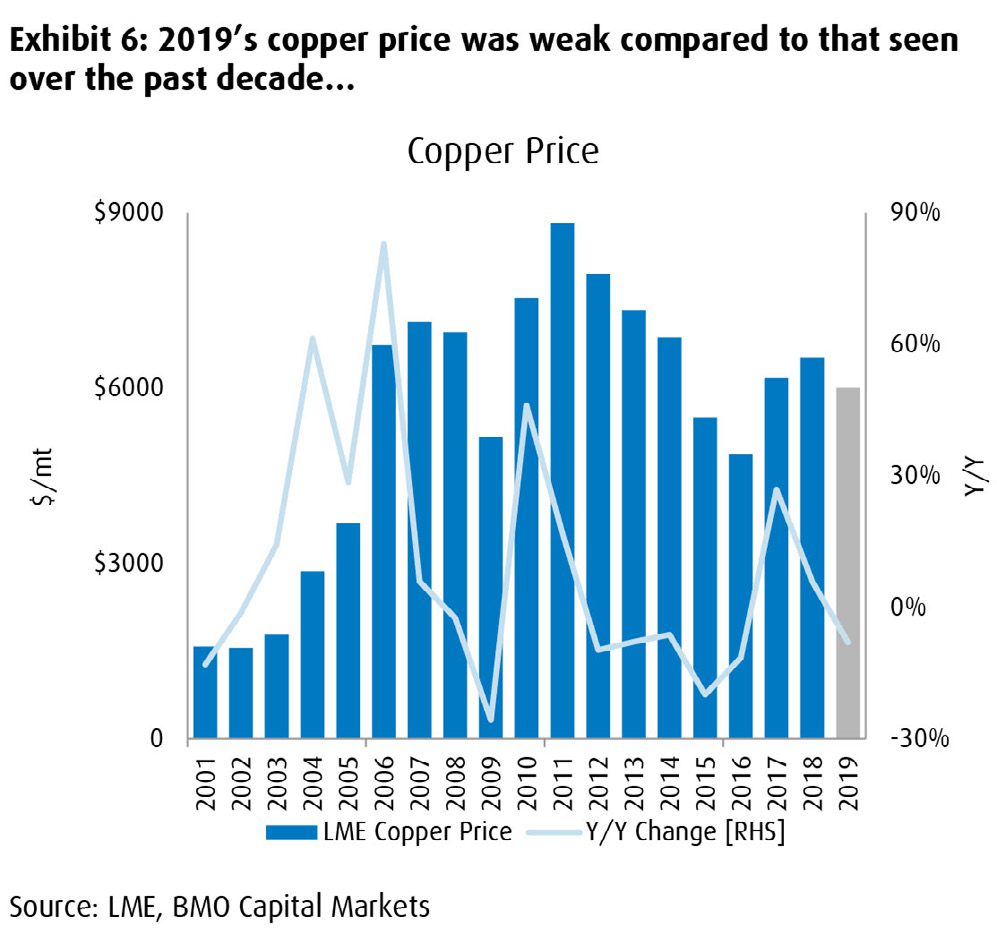
Meanwhile, there is some concern that spending by the State Grid – the world’s largest single copper consumer – will struggle again this year. We share some of these concerns, though note that local governments look to be taking back control of distribution upgrades in their cities, such that State Grid projects are now being done by others in the economy. On a longer-term perspective, the intensity of copper use in city grids continues to increase to support increased electrification needs, though the push to move semi-rural high voltage cables underground will likely stall in 2020.
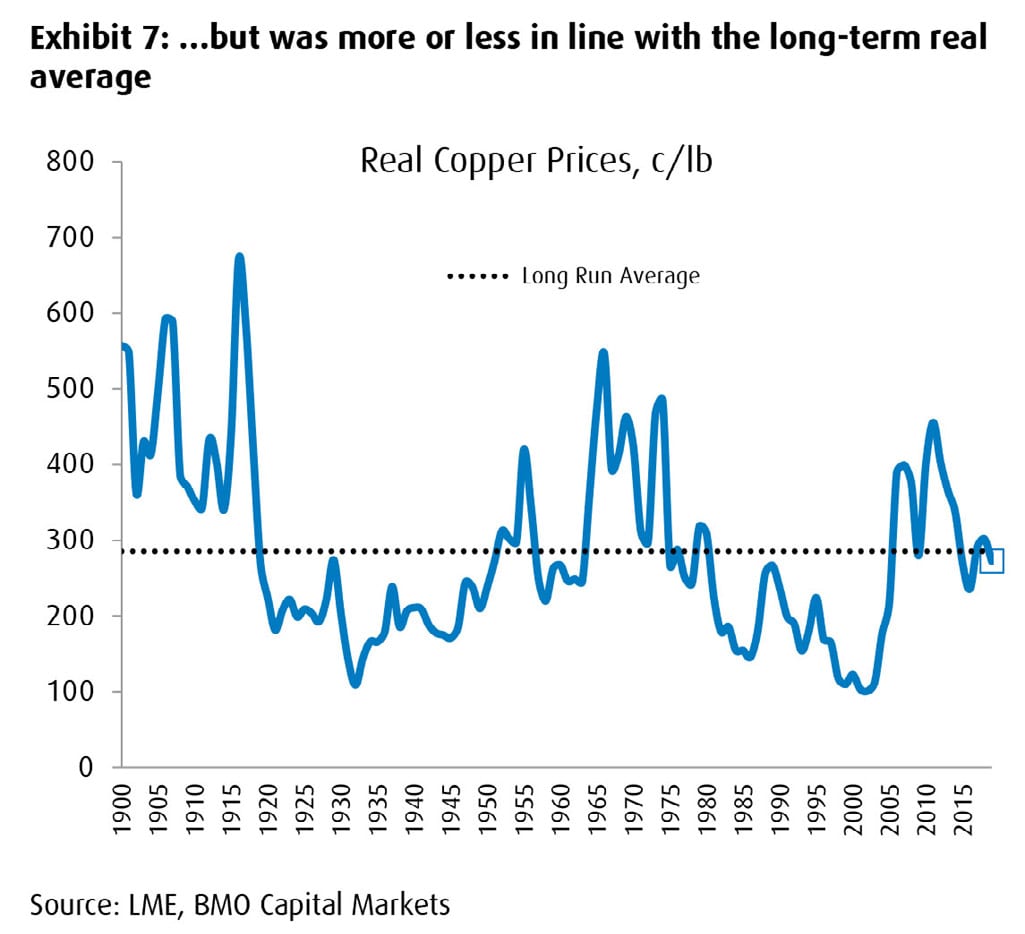
China is only part of the story however. And while Chinese demand disappointed last year, the big miss was ex-China. Moreover, this is not a new problem, indeed developed world copper consumption has barely recovered since the global financial crisis and is still ~2mtpa below 2006 levels.
Should we see a more aggressive ex-China recovery, then the drive to secure units becomes even more impactful. This is particularly the case given available inventories (exchange, producer plus China bonded) are extremely low in weeks of consumption. Indeed, the pinchpoint chart in exhibit 19 highlights that, for current inventory levels, the price premium to the cost curve is at the low end of the typical distribution, leaving an upside skew of risk to price. Should ex-China demand come through stronger than expected, particularly into the seasonally strong Q2, then a copper spike cannot be precluded.
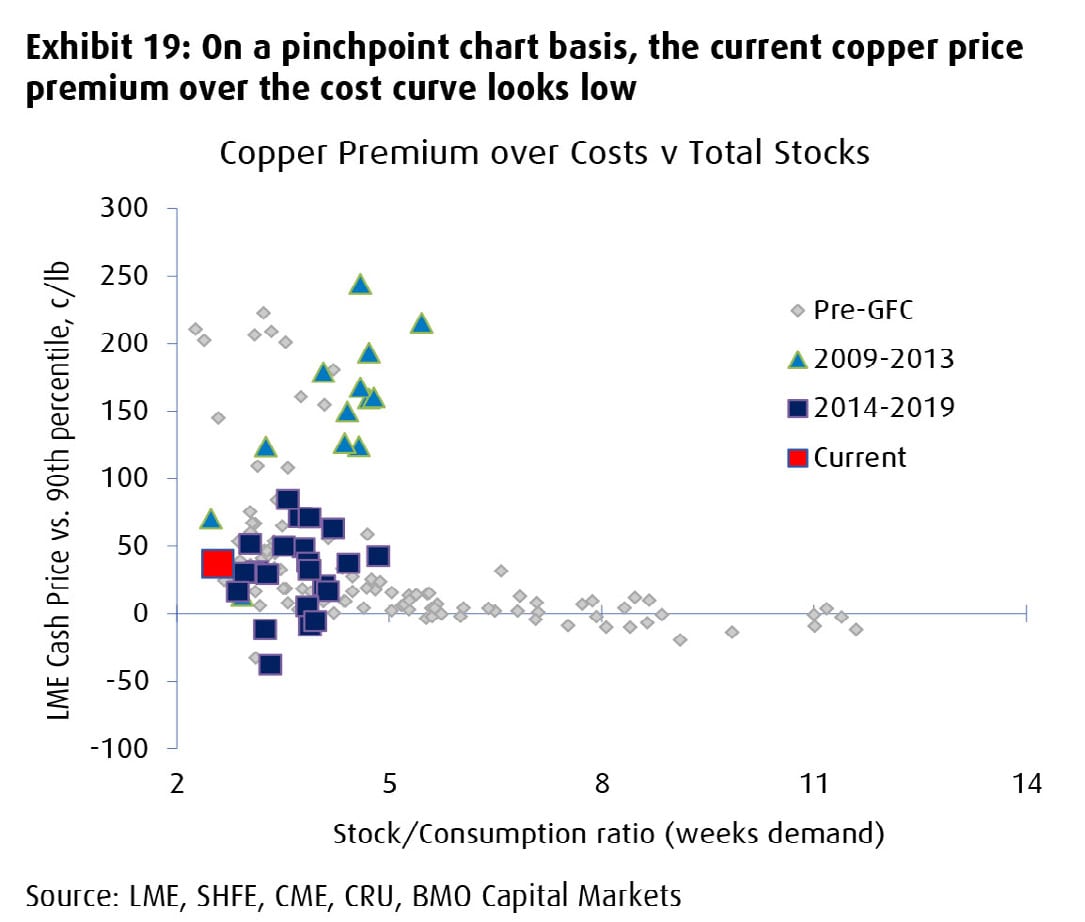
The best way to evidence the extent of ex-China gains is typically through Chinese imports. Every year in the copper market, part of the challenge is working out how China will source its copper needs. And typically this is made up of a combination of concentrate, cathode, blister and scrap. For 2020, we see a second consecutive year of little net growth in Chinese imports. While for 2018 this was due to a lack of supply growth, for 2020 we anticipate the modest ex-China recovery will take away some units. The China business model of more concentrate and less refined imports will persist – indeed after making up 50% of China’s copper unit imports this year we expect concentrate to rise to 64% in 2025 – but blister and refined imports are set to be down again.
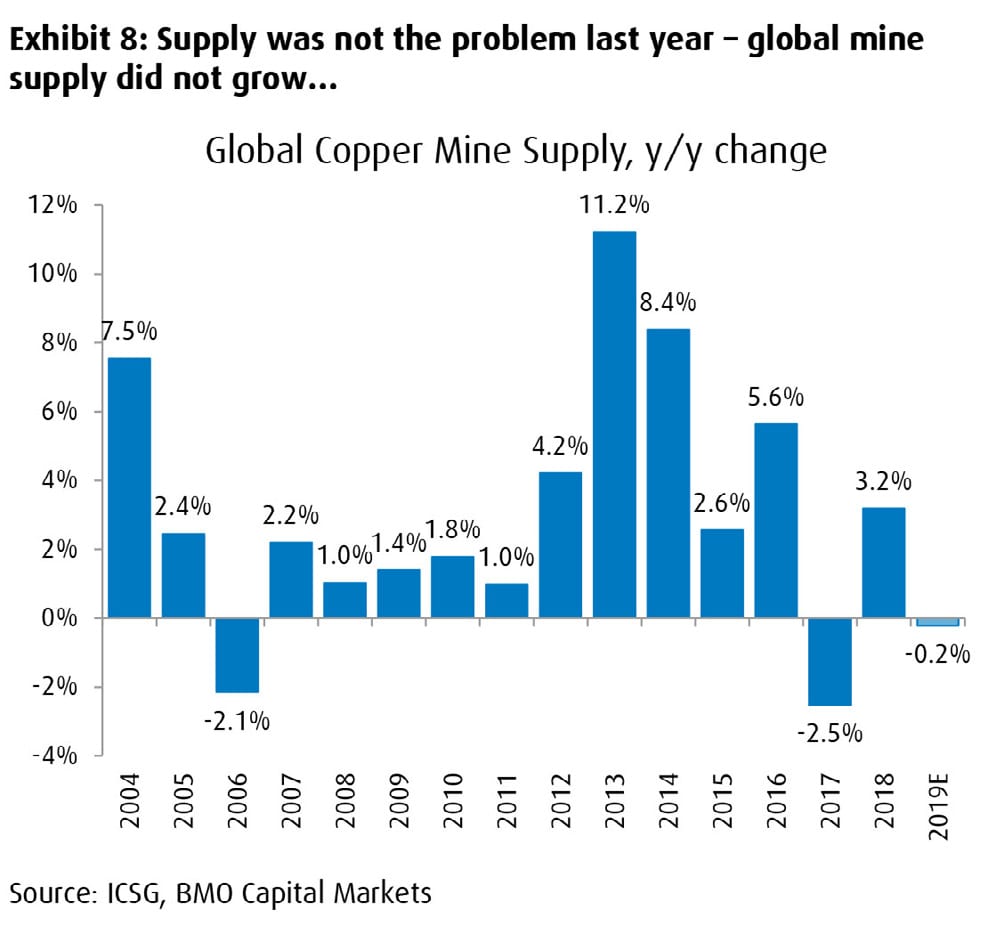
On the scrap side, China’s change in policy to reduce ‘waste’ imports has certainly had effect. Following the category 7 ban and quotas on other material, gross weight volumes have shrunk, however average-scrap grade import has risen to partially offset this. 2020’s scrap market change is the rebranding of higher grade units as ‘recyclable raw material’, taking them out of the waste trade code. This is expected from July 1, but initial determinations from the CNIA (as reported by Fastmarkets MB) point to some very high cut-off levels in order to qualify. We expect a lot more mixed, low-grade scrap to flow into India for processing, with China focusing more on developing domestic scrap recovery.
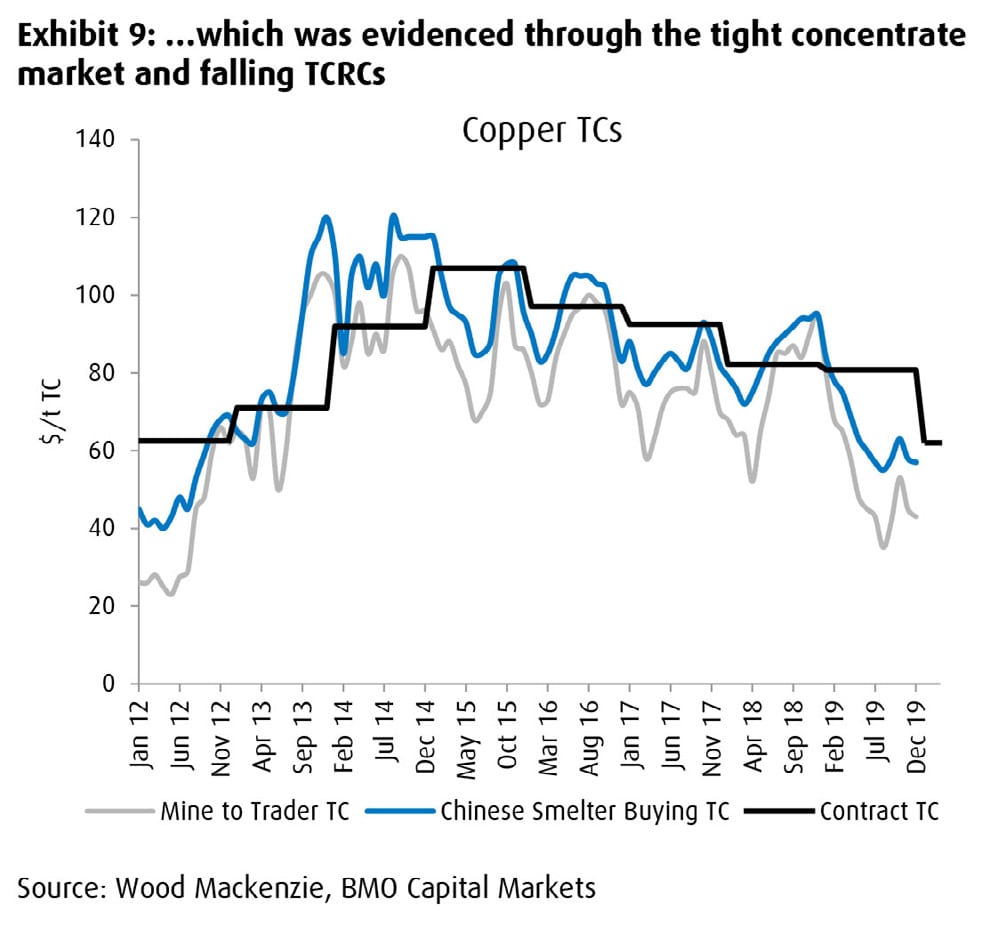
One theme we expect to be prevalent in copper in 2020 is smelter consolidation. With the concentrate market remaining tight, and prices potentially gaining, this is typically a period we would see such corporate activity as clear winners and losers emerge. We see global smelter utilisation rates as being too low to be sustainable, and with debt repayments in China for newly-built capacity likely becoming more of a concern we would anticipate a combination of policy and economics to drive the larger smelting companies to absorb underperforming assets. Should this occur, the current contract Treatment and Refining Charges could be at a cyclical low. Indeed, one thing we would be looking for as an early indicator that the period of 2020 fundamental strength may be starting to wane is treatment and refining charges starting to move rapidly higher – just as seen with zinc in late 2018 and with copper previously in 2012-13. Should this happen, it would be wise to pare back copper exposure.
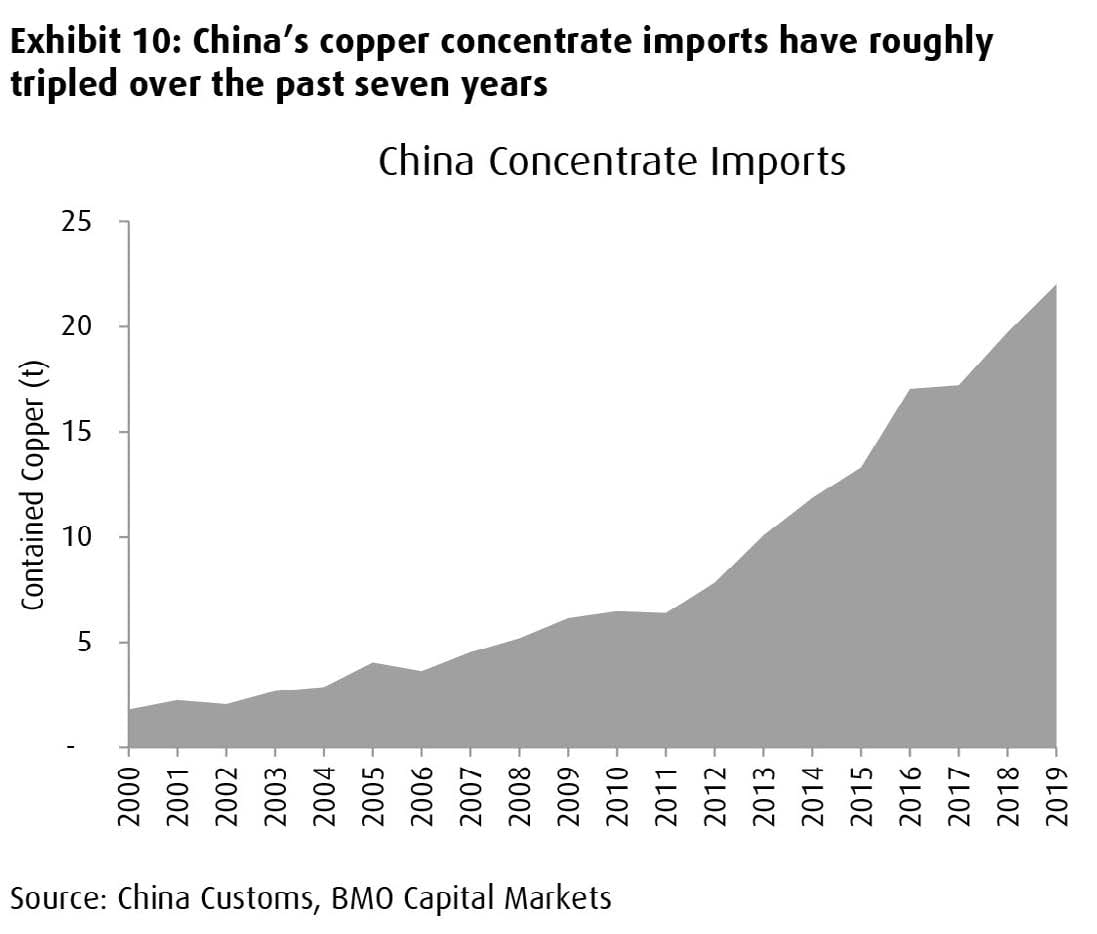 2021-2023 – Absorbing New Mine Supply Growth
2021-2023 – Absorbing New Mine Supply Growth
While 2020 could well mark the largest copper deficit in recent history, on our modelling it is a transient one. The past few years have seen limited mine supply growth on the back of capital spending declines in 2014-15, so the higher prices seen in mid-2018 saw a number of projects approved, which are now well on their way to market and will have to be accommodated over the 2021-2023 period.
Before we get into the details of this, it is important to note that modelled copper supply has frequently proven too optimistic over time. This is partly why we build a disruption allowance into the copper model. Notwithstanding this, copper supply has grown steadily over the past fifteen years, and while individual countries have their ups and downs the general trend has been upwards. Peru has been the single largest driver of growth on both a five and fifteen year view, followed by the Democratic Republic of Congo. Notably, Chilean output is essentially flat on 2004 levels.
That is not to say Chile has had a lack of projects, nor is there a lack of projects over the coming years. However, in many cases these are just to offset depletion at existing assets. The prime example of this is the world’s largest copper miner, Codelco, as we discussed in this note. We reiterate our concerns over delivery of the mine level transition at El Teniente in 2023, given that in the past five years this project has only gone from 24% complete to 54%. The current pace would see first copper in ~2030. And even assuming this accelerates, we see a ~350kt drop in Codelco output over 2018 levels by 2025. Thus, even with new projects we see Chile’s ex-growth trend as persisting, and once again Peru and the DRC will be the largest growth countries.
One thing we have noted in copper in recent years is the steady drop in the project pipeline over time. And the latest data from Wood Mackenzie shows that, for 2020, the trend continues with the lowest number of projects and lowest combined project capacity viewed as being ‘probable’ to come to market, than at any previous point this century. However, much of the drop this year reflects the fact that projects in the pipeline have been progressed to the construction phase and moved to base case – in other words the pipeline may be thin for copper, but the execution rate is high. Indeed, adding in the brownfield replacement projects such as those at Grasberg, Chuquicamata and El Teniente, the coming years will see >3mt of ‘new’ copper capacity added.
Of these, however, certainly the new greenfield projects are the most impactful, as these represent incremental copper units coming to market. Moreover, many of these are meaningful in size, and are being executed by large mining companies with technical expertise and financial clout. There is always the risk of delay (and overspend), as evidenced from the latest announcement about Oyu Tolgoi in Rio Tinto’s Q4 production report, but there is no doubt that these projects are coming. However, we would note that the capital intensity of these projects (with notable exceptions) is above the averages seen in recent decades, highlighting one reason commodity analysts typically like copper – the incremental projects are on average lower grade, higher in infrastructure requirement and more challenging from an environmental and jurisdictional risk perspective than the existing asset base, and thus dilutive.
These projects will add to concentrate & SXEW(Solvent extraction and electrowinning) supply in the global market, which will have to be absorbed. And given the scale of new projects all more or less coming at the same time, this will involve both a lower price and refined inventory build – the addition of these projects will be impactful to the copper market. However, to put this in context, exhibit 34 looks at the longer history of copper mine supply growth and the gains we expect over the next five years. While the net growth in copper mine supply will be ~2mtpa, in the previous capexled cycle of 2012-16 almost 5mt was added, and the average copper price over this period was still in excess of $2.65/lb or
$6,000/t.
Helping the market cope with this new supply will be diminishing performance at existing mines. While the transitions for Codelco and Freeport are well appreciated, other large, long-life mines are also operating below capacity. Moreover, global SXEW copper production is on a declining trend, with roughly ten assets per annum coming to end of life through the middle of the next decade, which combined account for almost half of current supply volumes. This is one of the major reasons the new mine supply growth is unlikely to be overwhelming for the copper market.
One other area which should play a major role in balancing the market is scrap. This is the most elastic form of supply to industry needs and price. As we have added supply projects to our model over the past year (and lowered medium-term pricing), we have also lowered scrap generation. We do expect an acceleration in China’s domestic scrap collection, which will help to arrest the fall in scrap use seen over recent years. However rather than 3mt incremental by 2025 we feel half this figure is now more appropriate. Longer term we do envisage ongoing increases in scrap consumption, not least to lower energy consumption and carbon intensity in copper production. But over the 2021-2024 period economics will win out. Given this, one factor we will be looking for as a sign that the fundamental copper outlook is tightening once more, is a falling scrap discount over 2023-2024, as a signal that the market is starting to need incremental units from the available raw material pool.
Long Term – Demand Growth the Key Differentiator
While supply goes through its steady cycles of growth, from a longer-term demand perspective copper has been a model of consistency. Other industrial metals may have seen more intense periods of growth, but from a global perspective copper has added between 2-3mt to its market size every five years since the mid-1990s. And of course, China has dominated that growth.
Given this, some of the longer-term concerns about copper relate to what happens to demand as China’s economic growth slows. In our view, copper’s differentiating factor from a demand perspective is that it is exposed to growing global thematics, not just those in China and other emerging economies.
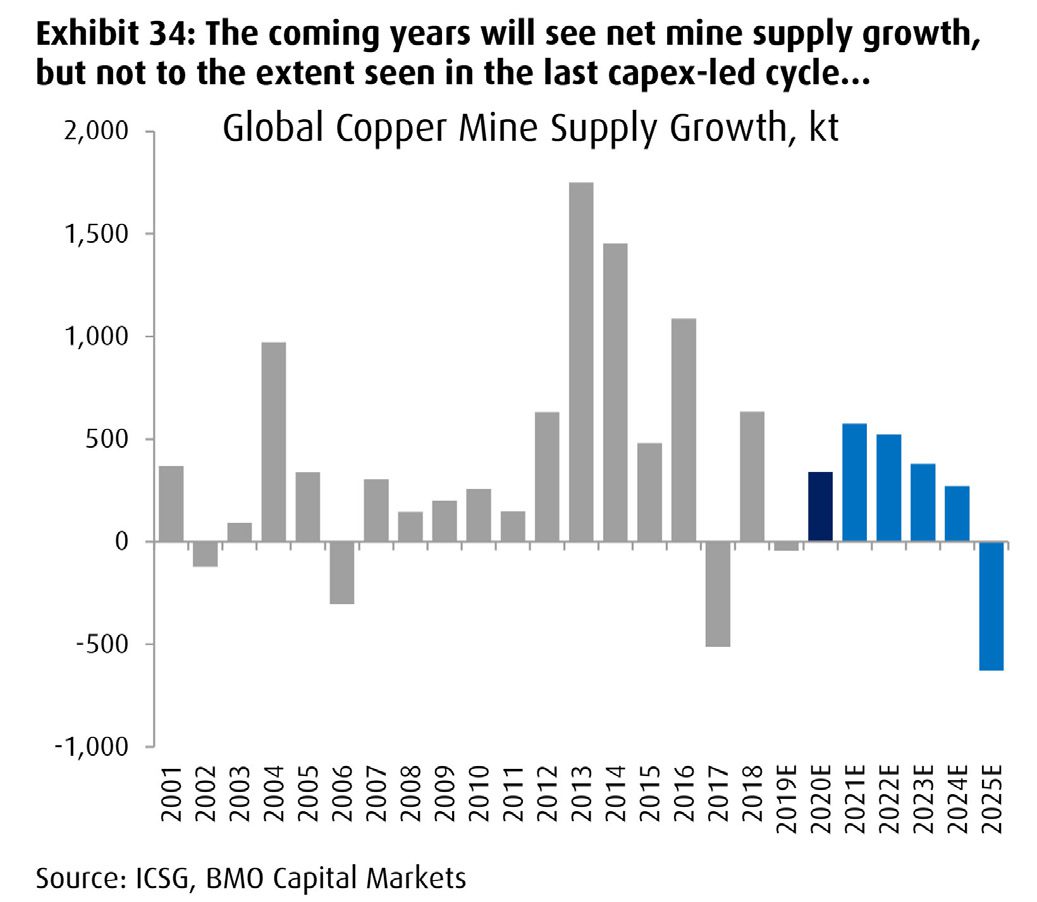
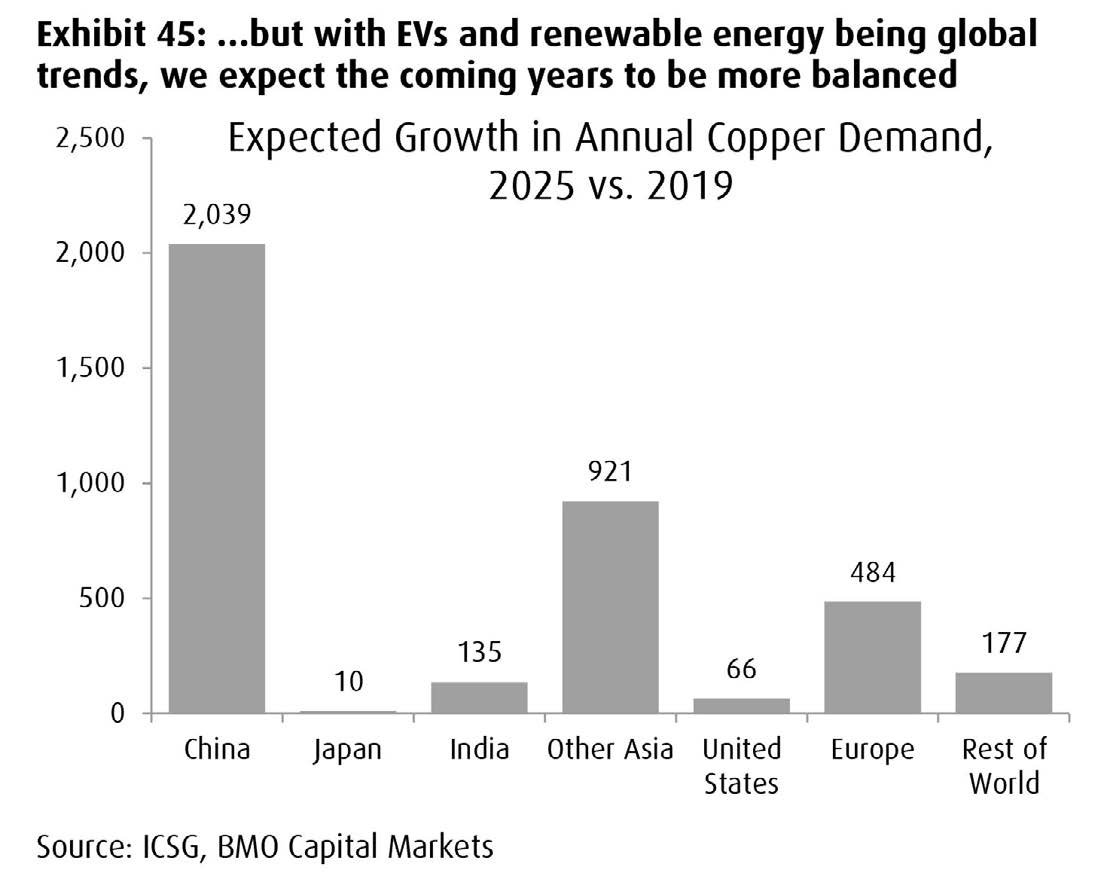
That is not to say that China’s growth story is over. Output of copper-intensive appliances continues to grow, as rural households move up the wealth curve. Moreover, auto ownership remains at a very low level compared to developed economies. To be clear, China’s copper consumption per capita is now high, but not as high as other industrial powerhouses have peaked at in the past. While consumption in the construction sector is likely to decline by 2025, we still see China adding 2mt to global net copper demand over this period helped by the ongoing trend of import substitution for capital and consumer goods.
This only represents just over half the global total, however – as exhibit 45 shows we expect all major regions to contribute to growth over the coming five years, which is a reversal of the trend seen in the developed world. The rationale for this is that as monetary policy is having incrementally less impact, there is potential for a greater fiscal push from nations under pressure to maintain growth. Europe is likely to lead the way on this, under direction from new Commissioner Ursula van der Loyen, with ‘green deals’ at the forefront of the agenda given they are more palatable to democratic populations. We essentially view this as following a China model – taking debt on the government balance sheet for improvement projects, and worrying about it later (in other words using social measures for investment rather than purely economic ones). With Europe planning to be carbon neutral by 2050 and other economies unde pressure to follow, we expect the start of a multi-year push in energy efficiency and renewable energy projects, which will support demand for copper.
The drivers of copper demand from the renewable energy and electric vehicle markets were something we discussed at length in our 2018 report “Renewable Energy: A Green Light to Copper Demand”. The technical details behind this and distinct uses discussed in this very much still hold true. Both are more copper intensive than incumbents in the same sector. We have however refreshed our demand assumptions in both areas.
2019 proved to be a challenging year for EV markets, as China sales fell short of expectations. However, with the auto industry now tooling up and constantly increasing the number of models planned for launch, the shift towards mainstream consumption is well underway. We did slightly downgrade our 2025 EV sales expectations at the end of last year; however, we also increased average battery pack size. As a result, we now model ~900kt of incremental copper demand from electric vehicles in 2025 versus 2019.
Meanwhile, one of the main concerns about electric vehicle penetration has been the provision of charging infrastructure. Certainly, the number of different chargers on the market is likely to prove unsustainable, but economics will naturally drive consolidation. Moreover, charger provision is likely to benefit from government fiscal spending – as an example, Germany has announced plans for a vast roll out of charging infrastructure by 2030, with a target 4x that of China on a per capita basis. While each individual charging pole uses little copper in its own right, upgrading the grid to come with additional power demand from these is a copper intensive process.
In total, we see ~4.7mtpa of copper demand growth in 2025 vs. 2019, covering a combination of primary metal and direct use scrap. Exhibit 51 shows how we see changes in the market balancing out over this period, with the net result being a 600kt supply shortfall. After the wave of current supply projects is in the market, we are likely to enter a period of supply growth scarcity once more, and without a market response, the 600kt shortfall is likely to grow significantly over the 2025-2030 period.
Copper Market Balance and Price Forecast
Pulling everything together, our primary copper demand CAGR of 2.3 through 2030 is lower than the trend seen over the past twenty years as China’s economy continues to transition. However, compared to peer metals the drop for copper is much smaller given the positive global demand thematics helping to increase penetration of use. We model a market deficit of 384kt in 2020 on an assumption of 2.2 global demand growth (for reference zero growth would give a ~150kt surplus). Heading into 2021 the delivery of new mine capacity leads to a period of surplus, before a deficit re-emerges through 2024.
It should be noted that, even with the ~665kt of inventory build over 2021-2023, in weeks of consumption inventory, cover will be lower than at end-2016 throughout our forecast period. The surplus is thus more inventory replenishment than heavy market imbalance. However, during 2022-2023 we have copper price trading roughly at the 90th percentile of the copper cost curve, which has proven to be a good reference in adequately suppled copper markets in the past.
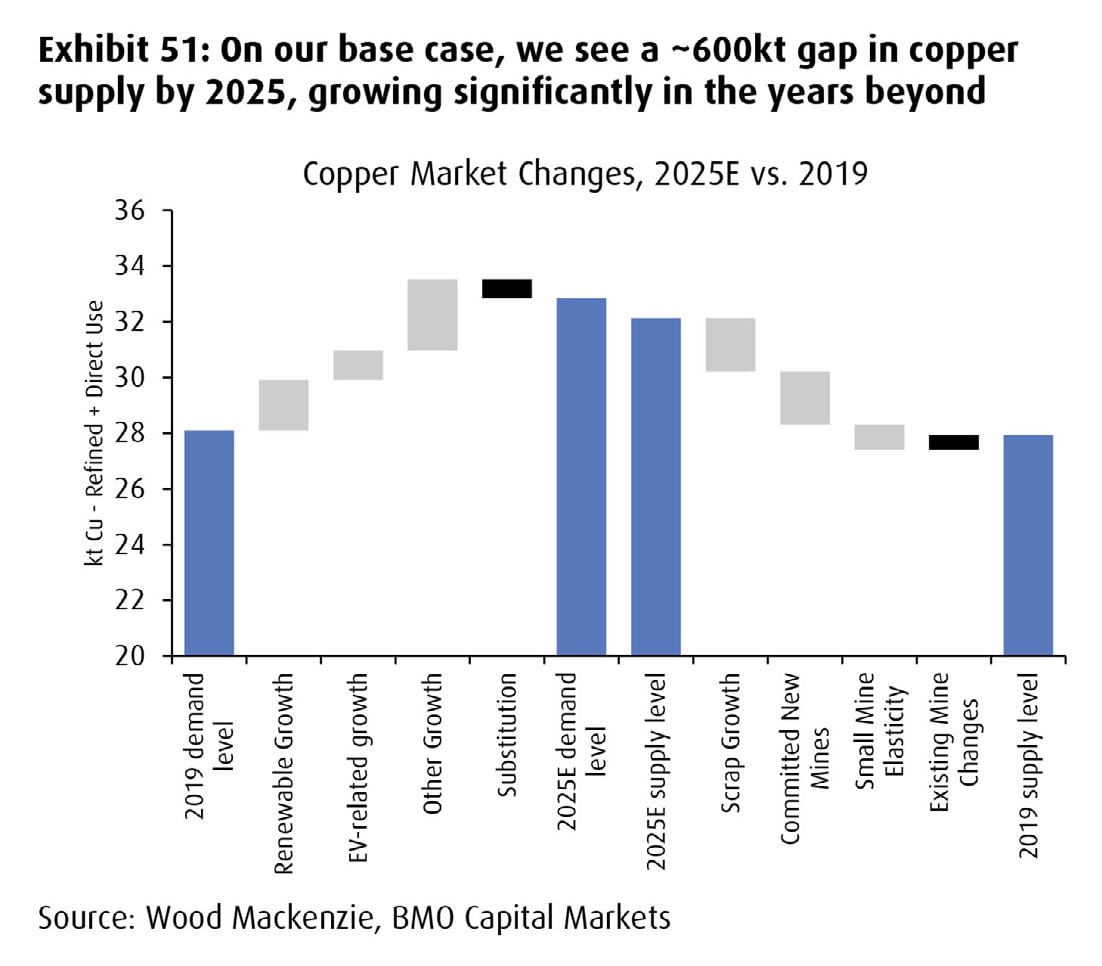
IMPORTANT DISCLOSURES
Analyst’s Certification
I, Colin Hamilton, hereby certify that the views expressed in this report accurately reflect my personal views about the subject securities or issuers. I also certify that no part of my compensation was, is, or will be, directly or indirectly, related to the specific recommendations or views expressed in this report.
Analysts who prepared this report are compensated based upon (among other factors) the overall profitability of BMO Capital Markets and their affiliates, which includes the overall profitability of investment banking services. Compensation for research is based on effectiveness in generating new ideas and in communication of ideas to clients, performance of recommendations, accuracy of earnings estimates, and service to clients.
Analysts employed by BMO Nesbitt Burns Inc. and/or BMO Capital Markets Limited are not registered as research analysts with FINRA. These analysts may not be associated persons of BMO Capital Markets Corp. and therefore may not be subject to the FINRA Rule 2241 restrictions on communications with a subject company, public appearances and trading securities held by a research analyst account.
Company Specific Disclosures
For Important Disclosures on the stocks discussed in this report, please go to https://researchglobal0.bmocapitalmarkets.com/public-disclosure/.
* Reflects rating distribution of all companies covered by BMO Capital Markets Corp. equity research analysts.
** Reflects rating distribution of all companies from which BMO Capital Markets Corp. has received compensation for Investment Banking services as percentage within ratings category.
*** Reflects rating distribution of all companies from which BMO Capital Markets Corp. has received compensation for Investment Banking services as percentage of Investment Banking clients.
**** Reflects rating distribution of all companies covered by BMO Capital Markets equity research analysts.
***** Reflects rating distribution of all companies from which BMO Capital Markets has received compensation for Investment Banking services as percentage of Investment
Banking clients.
~ As of April 1, 2019.
Other Important Disclosures
For Important Disclosures on the stocks discussed in this report, please go to https://researchglobal0.bmocapitalmarkets. com/public-disclosure/ or write to Editorial Department, BMO Capital Markets, 3 Times Square, New York, NY 10036 or Editorial Department, BMO Capital Markets, 1 First Canadian Place, Toronto, Ontario, M5X 1H3.
Dissemination of Research
Dissemination of BMO Capital Markets Equity Research is available via our website https://researchglobal0.bmocapitalmarkets. com/ Institutional clients may also receive our research via Thomson Reuters, Bloomberg, FactSet, and Capital IQ. Research reports and other commentary are required to be simultaneously disseminated internally and externally to our clients. Research coverage of licensed cannabis producers and other cannabis-related companies is made available only to eligible approved North American, Australian, and EUbased BMO Nesbitt Burns Inc., BMO Capital Markets Limited, and BMO Capital Markets Corp. clients via email, our website and select third party platforms.
~ Research distribution and approval times are provided on the cover of each report. Times are approximations as system and distribution processes are not exact and can vary based on the sender and recipients’ services. Unless otherwise noted, times are Eastern Standard and when two times are provided, the approval time precedes the distribution time. BMO Capital Markets may use proprietary models in the preparation of reports. Material information about such models may be obtained by contacting the research analyst directly. There is no planned frequency of updates to this report. For recommendations disseminated during the preceding 12-month period, please visit: https://researchglobal0.bmocapitalmarkets. com/public- disclosure/.
General Disclaimer
BMO Capital Markets” is a trade name used by the BMO Investment Banking Group, which includes the wholesale arm of Bank of Montreal and its subsidiaries BMO Nesbitt Burns Inc., BMO Capital Markets Limited in the U.K., Bank of Montreal Europe Plc in Ireland and BMO Capital Markets Corp. in the U.S. BMO Nesbitt Burns Inc., BMO Capital Markets Limited, Bank of Montreal Europe Plc and BMO Capital Markets Corp are affiliates. Bank of Montreal or its subsidiaries (“BMO Financial Group”) has lending arrangements with, or provide other remunerated services to, many issuers covered by BMO Capital Markets. The opinions, estimates and projections contained in this report are those of BMO Capital Markets as of the date of this report and are subject to change without notice. BMO Capital Markets endeavours to ensure that the contents have been compiled or derived from sources that we believe are reliable and contain information and opinions that are accurate and complete. However, BMO Capital Markets makes no representation or warranty, express or implied, in respect thereof, takes no responsibility for any errors and omissions contained herein and accepts no liability whatsoever for any loss arising from any use of, or reliance on, this report or its contents. Information may be available to BMO Capital Markets or its affiliates that is not reflected in this report. The information in this report is not intended to be used as the primary basis of investment decisions, and because of individual client objectives, should not be construed as advice designed to meet the particular investment needs of any investor. Nothing herein constitutes any investment, legal, tax or other advice nor is it to be relied on in any investment or decision. If you are in doubt about any of the contents of this document, the reader should obtain independent professional advice. This material is for information purposes only and is not an offer to sell or the solicitation of an offer to buy any security. BMO Capital Markets or its affiliates will buy from or sell to customers the securities of issuers mentioned in this report on a principal basis. BMO Capital Markets or its affiliates, officers, directors or employees have a long or short position in many of the securities discussed herein, related securities or in options, futures or other derivative instruments based thereon. The reader should assume that BMO Capital Markets or its affiliates may have a conflict of interest and should not rely solely on this report in evaluating whether or not to buy or sell securities of issuers discussed herein.
Additional Matters
This report is directed only at entities or persons in jurisdictions or countries where access to and use of the information is not contrary to local laws or regulations. Its contents have not been reviewed by any regulatory authority. BMO Capital Markets does not represent that this report may be lawfully distributed or that any financial products may be lawfully offered or dealt with, in compliance with regulatory requirements in other jurisdictions, or pursuant to an exemption available thereunder.
To Australian residents: BMO Capital Markets Limited is exempt from the requirement to hold an Australian financial services licence under the Corporations Act and is regulated by the UK Financial Conduct Authority under UK laws, which differ from Australian laws. This document is only intended for wholesale clients (as defined in the Corporations Act 2001) and Eligible Counterparties or Professional Clients (as defined in Annex II to MiFID II).
To Canadian Residents: BMO Nesbitt Burns Inc. furnishes this report to Canadian residents and accepts responsibility for the contents herein subject to the terms set out above. Any Canadian person wishing to effect transactions in any of the securities included in this report should do so through BMO Nesbitt Burns Inc.
The following applies if this research was prepared in whole or in part by Colin Hamilton, Alexander Pearce, David Round or Edward Sterck: This research is not prepared subject to Canadian disclosure requirements. This research is prepared by BMO Capital Markets Limited and distributed by BMO Capital Markets Limited or Bank of Montreal Europe Plc and is subject to the regulations of the Financial Conduct Authority (FCA) in the United Kingdom and the Central Bank of Ireland (CBI) in Ireland. FCA and CBI regulations require that a firm providing research disclose its ownership interest in the issuer that is the subject of the research if it and its affiliates own 5 or more of the equity of the issuer. Canadian regulations require that a firm providing research disclose its ownership interest in the issuer that is the subject of the research if it and its affiliates own 1 or more of the equity of the issuer that is the subject of the research. Therefore each of BMO Capital Markets Limited and Bank of Montreal Europe Plc will disclose its and its affiliates’ ownership interest in the subject issuer only if such ownership exceeds 5 of the equity of the issuer. To E.U. Residents: In an E.U. Member State this document is issued and distributed by Bank of Montreal Europe plc which is authorised and regulated in Ireland and operates in the E.U. on a passported basis. This document is only intended for Eligible Counterparties or Professional Clients, as defined in Annex II to “Markets in Financial Instruments Directive” 2014/65/EU (“MiFID II”).
Singapore: This disclaimer applies to research reports distributed by the Private Banking unit of Bank of Montreal, Singapore Branch (“BMO SG”), an exempt financial adviser under the Financial Advisers Act (Cap. 110) of Singapore (“FAA”) only. This research report is prepared by BMO Capital Markets and distributed by BMO SG pursuant to an arrangement under regulation 32C of the Financial Advisers Regulations of Singapore. This research report is distributed by BMO SG solely to persons who qualify as accredited investors as defined in the FAA only, and is not intended for and may not be circulated to the general public. This report and any information contained in this report shall not be disclosed to any other person. If you are not an accredited investor, please disregard this report. BMO SG does not accept legal responsibility for the contents of the report. Recipients should contact BMO SG at 65-6535 2323 for matters arising from, or in connection with the report.
To U.S. Residents: BMO Capital Markets Corp. furnishes this report to U.S. residents and accepts responsibility for the contents herein, except to the extent that it refers to securities of Bank of Montreal. Any U.S. person wishing to effect transactions in any security discussed herein should do so through BMO Capital Markets Corp.
To U.K. Residents: In the UK this document is published by BMO Capital Markets Limited which is authorised and regulated by the Financial Conduct Authority. The contents hereof are intended solely for the use of, and may only be issued or passed on to, (I) persons who have professional experience in matters relating to investments falling within Article 19(5) of the Financial Services and Markets Act 2000 (Financial Promotion) Order 2005 (the “Order”) or (II) high net worth entities falling within Article 49(2)(a) to (d) of the Order (all such persons together referred to as “relevant persons”). The contents hereof are not intended for the use of and may not be issued or passed on to retail clients.
To Israeli residents: BMO Capital Markets is not licensed under the Israeli Law for the Regulation of Investment Advice, Investment Marketing and Portfolio Management of 1995 (the “Advice Law”) nor does it carry insurance as required thereunder. This document is to be distributed solely to persons that are qualified clients (as defined under the Advice Law) and qualified investors under the Israeli Securities Law of 1968. This document represents the analysis of the analyst but there is no assurance that any assumption or estimation will materialize.
These documents are provided to you on the express understanding that they must be held in complete confidence and not republished, retransmitted, distributed, disclosed, or otherwise made available, in whole or in part, directly or indirectly, in hard or soft copy, through any means, to any person, except with the prior written consent of BMO Capital Markets.
Click here for data vendor disclosures when referenced within a BMO Capital Markets research document.












